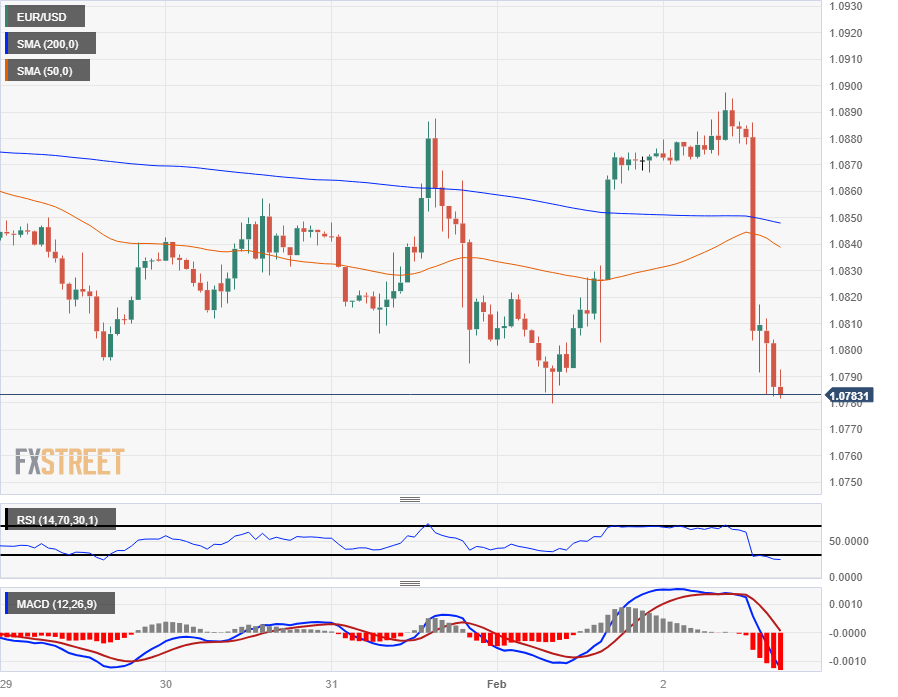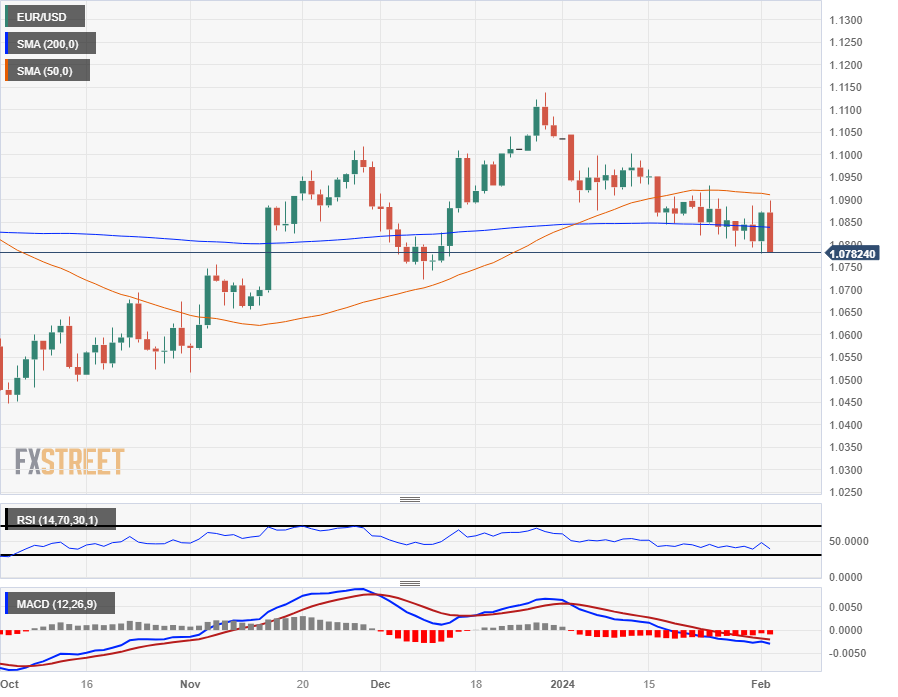- EUR/USD loses key technical handle after US Jobs Report thumps forecasts.
- US NFP hits highest level in a year, March rate cut hopes all but buried.
- US Average Hourly Earnings also gained ground in January.
EUR/USD continues to churn on Friday, keeping a near-term choppy technical pattern intact as the Euro (EUR) cycles against the US Dollar (USD).
US Nonfarm Payrolls wildly outperformed market expectations, hitting a one-year high and bringing sharp upside revisions to previous datapoints. Investors hoping for faster, sooner rate cuts from the US Federal Reserve (Fed) have seen rate cut hopes dwindle as the US domestic economy continues to surprise with its sturdiness.
Daily digest market movers: EUR/USD back into familiar lows as cyclical pattern drags the pair down.
- EUR/USD climbed into 1.0900 early Friday before getting dragged back down post-NFP.
- US Nonfarm Payrolls climbed to 353K in January, vaulting well over the forecast 180K.
- US Nonfarm Payrolls: surge 353,000 in January
- December’s NFP figure also saw a sharp upside revision to 333K from 216K.
- YoY US Average Hourly Earnings also gained in January, coming in at 4.5% versus the forecast 4.1% and the previous period’s 4.4% (revised upwards from 4.1%).
- MoM US Average Hourly Earnings climbed 0.6% in January versus the forecast 0.3%, 0.4% last.
- US Unemployment Rate held steady at 3.7% in January; markets expected a tick upwards to 3.8%.
- Michigan Consumer Sentiment Index gained to 79.0, above the forecast 78.9 and climbing further above the previous month’s 78.8.
Euro price today
The table below shows the percentage change of Euro (EUR) against listed major currencies today. Euro was the strongest against the Japanese Yen.
| USD | EUR | GBP | CAD | AUD | JPY | NZD | CHF | |
| USD | 0.82% | 0.97% | 0.62% | 1.02% | 1.35% | 1.30% | 1.16% | |
| EUR | -0.82% | 0.17% | -0.21% | 0.19% | 0.52% | 0.50% | 0.32% | |
| GBP | -0.96% | -0.15% | -0.32% | 0.06% | 0.38% | 0.33% | 0.20% | |
| CAD | -0.64% | 0.18% | 0.34% | 0.39% | 0.72% | 0.67% | 0.51% | |
| AUD | -1.01% | -0.19% | -0.02% | -0.36% | 0.32% | 0.31% | 0.12% | |
| JPY | -1.37% | -0.51% | -0.34% | -0.74% | -0.33% | 0.01% | -0.20% | |
| NZD | -1.32% | -0.50% | -0.33% | -0.71% | -0.31% | 0.00% | -0.15% | |
| CHF | -1.16% | -0.32% | -0.15% | -0.52% | -0.12% | 0.20% | 0.18% |
The heat map shows percentage changes of major currencies against each other. The base currency is picked from the left column, while the quote currency is picked from the top row. For example, if you pick the Euro from the left column and move along the horizontal line to the Japanese Yen, the percentage change displayed in the box will represent EUR (base)/JPY (quote).
Technical analysis: EUR/USD steeply off recent highs as whipsaw pattern remains
EUR/USD came within touching distance of 1.0900 early Friday, but the pair got dragged back into familiar lows below 1.0800 near 1. 0780.
Friday’s bearish action sees the EUR/USD tumble out of a familiar consolidation zone between the 200-day and 50-day Simple Moving Averages (SMA), between 1.0900 and 1.0850.
The EUR/USD continues to drift into the low side in choppy trading, and the pair is down over 3% from December’s swing high into 1.1140.
EUR/USD hourly chart
EUR/USD daily chart
Euro FAQs
What is the Euro?
The Euro is the currency for the 20 European Union countries that belong to the Eurozone. It is the second most heavily traded currency in the world behind the US Dollar. In 2022, it accounted for 31% of all foreign exchange transactions, with an average daily turnover of over $2.2 trillion a day.
EUR/USD is the most heavily traded currency pair in the world, accounting for an estimated 30% off all transactions, followed by EUR/JPY (4%), EUR/GBP (3%) and EUR/AUD (2%).
What is the ECB and how does it impact the Euro?
The European Central Bank (ECB) in Frankfurt, Germany, is the reserve bank for the Eurozone. The ECB sets interest rates and manages monetary policy.
The ECB’s primary mandate is to maintain price stability, which means either controlling inflation or stimulating growth. Its primary tool is the raising or lowering of interest rates. Relatively high interest rates – or the expectation of higher rates – will usually benefit the Euro and vice versa.
The ECB Governing Council makes monetary policy decisions at meetings held eight times a year. Decisions are made by heads of the Eurozone national banks and six permanent members, including the President of the ECB, Christine Lagarde.
How does inflation data impact the value of the Euro?
Eurozone inflation data, measured by the Harmonized Index of Consumer Prices (HICP), is an important econometric for the Euro. If inflation rises more than expected, especially if above the ECB’s 2% target, it obliges the ECB to raise interest rates to bring it back under control.
Relatively high interest rates compared to its counterparts will usually benefit the Euro, as it makes the region more attractive as a place for global investors to park their money.
How does economic data influence the value of the Euro?
Data releases gauge the health of the economy and can impact on the Euro. Indicators such as GDP, Manufacturing and Services PMIs, employment, and consumer sentiment surveys can all influence the direction of the single currency.
A strong economy is good for the Euro. Not only does it attract more foreign investment but it may encourage the ECB to put up interest rates, which will directly strengthen the Euro. Otherwise, if economic data is weak, the Euro is likely to fall.
Economic data for the four largest economies in the euro area (Germany, France, Italy and Spain) are especially significant, as they account for 75% of the Eurozone’s economy.
How does the Trade Balance impact the Euro?
Another significant data release for the Euro is the Trade Balance. This indicator measures the difference between what a country earns from its exports and what it spends on imports over a given period.
If a country produces highly sought after exports then its currency will gain in value purely from the extra demand created from foreign buyers seeking to purchase these goods. Therefore, a positive net Trade Balance strengthens a currency and vice versa for a negative balance.
Information on these pages contains forward-looking statements that involve risks and uncertainties. Markets and instruments profiled on this page are for informational purposes only and should not in any way come across as a recommendation to buy or sell in these assets. You should do your own thorough research before making any investment decisions. FXStreet does not in any way guarantee that this information is free from mistakes, errors, or material misstatements. It also does not guarantee that this information is of a timely nature. Investing in Open Markets involves a great deal of risk, including the loss of all or a portion of your investment, as well as emotional distress. All risks, losses and costs associated with investing, including total loss of principal, are your responsibility. The views and opinions expressed in this article are those of the authors and do not necessarily reflect the official policy or position of FXStreet nor its advertisers. The author will not be held responsible for information that is found at the end of links posted on this page.
If not otherwise explicitly mentioned in the body of the article, at the time of writing, the author has no position in any stock mentioned in this article and no business relationship with any company mentioned. The author has not received compensation for writing this article, other than from FXStreet.
FXStreet and the author do not provide personalized recommendations. The author makes no representations as to the accuracy, completeness, or suitability of this information. FXStreet and the author will not be liable for any errors, omissions or any losses, injuries or damages arising from this information and its display or use. Errors and omissions excepted.
The author and FXStreet are not registered investment advisors and nothing in this article is intended to be investment advice.
Recommended content
Editors’ Picks
EUR/USD edges lower toward 1.0700 post-US PCE

EUR/USD stays under modest bearish pressure but manages to hold above 1.0700 in the American session on Friday. The US Dollar (USD) gathers strength against its rivals after the stronger-than-forecast PCE inflation data, not allowing the pair to gain traction.
GBP/USD retreats to 1.2500 on renewed USD strength

GBP/USD lost its traction and turned negative on the day near 1.2500. Following the stronger-than-expected PCE inflation readings from the US, the USD stays resilient and makes it difficult for the pair to gather recovery momentum.
Gold struggles to hold above $2,350 following US inflation

Gold turned south and declined toward $2,340, erasing a large portion of its daily gains, as the USD benefited from PCE inflation data. The benchmark 10-year US yield, however, stays in negative territory and helps XAU/USD limit its losses.
Bitcoin Weekly Forecast: BTC’s next breakout could propel it to $80,000 Premium

Bitcoin’s recent price consolidation could be nearing its end as technical indicators and on-chain metrics suggest a potential upward breakout. However, this move would not be straightforward and could punish impatient investors.
Week ahead – Hawkish risk as Fed and NFP on tap, Eurozone data eyed too

Fed meets on Wednesday as US inflation stays elevated. Will Friday’s jobs report bring relief or more angst for the markets? Eurozone flash GDP and CPI numbers in focus for the Euro.